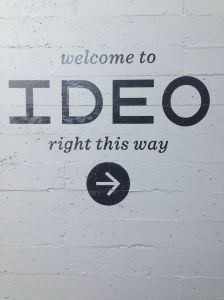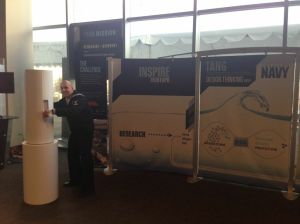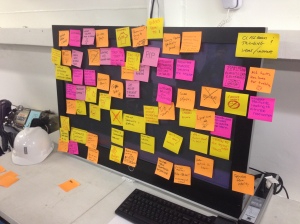By: LT Dave Nobles
Last week, I was honored to attend Fast Company’s Innovation Uncensored 2014 in San Francisco to share the story of Military Innovation with a broader audience.
The magazine invited the team from Tactical Advancements for the Next Generation (TANG), to present to a room full of forward thinkers from Silicon Valley and beyond who learned that the Navy not only has an appetite for fresh ideas and creative solutions to complex problems, but that there are movements afoot that are turning those ideas into action. Fittingly, the event was on Veteran’s Day and the conference center at San Francisco’s Metreon was filled with energy and excitement for TANG.
TANG is an initiative that brings together warfighters, decision makers and engineers to tackle problems using design thinking tools. Since 2011, Johns Hopkins University’s Applied Physics Laboratory (APL) has worked together with the international innovation consultancy and design firm IDEO and the Program Executive Office for Integrated Warfare Systems to gain operator insight and transition cutting-edge programs rapidly to the Fleet. One of the amazing things that TANG brings to the table is speed – The team is able to swiftly move from Post-It Notes and a foam-core design at a workshop to a working prototype in a matter of months, and more importantly from a prototype to a functional system onto a Navy platform in less than two years. Lightning speed, in terms of the current acquisitions pipelines in the Department of Defense.
Through several events, chiefly focused in Anti-Submarine Warfare both on Submarines and Surface Ships, the initiative is beginning to gain traction in many other fields of the Navy. During the San Francisco visit for the conference, the TANG team was able to sneak away to IDEO’s Palo Alto offices to discuss what topics upcoming workshops will attack with Design Thinking and Creative Confidence. More to come on that.

No trip to the Bay Area is complete without dropping by to hang with the gang at IDEO – Big things coming in the future!
Beyond the interest and respect that the initiative has gained within the Fleet, the invitation to present the TANG story alongside other top-tier innovative minds like Disney’s Ed Catmull, Lyft CEO John Zimmer and Samsung’s Vice President and Head of Design Dennis Miloseski marks a validation of the innovative work that the team has accomplished in the epicenter of corporate innovation, Silicon Valley.
The director of TANG, Johns Hopkins APL’s Josh Smith, in a conversation on stage with Fast Company’s Chuck Salter, talked about some of the initiatives TANG has put into play already on Submarines, like replacing a bulky $128K joystick for periscope control with an Xbox controller.
“These Sailors have great ideas and they want to make things better,” Smith said. “We give them the tools to unleash their creativity and watch the magic happen.”
Those tools are the unique brainstorming rules developed by IDEO that the team employs at every TANG workshop, bringing Sailors from all over the Fleet together to generate powerful new concepts for the warfighter. A couple of those ideas: Defer Judgement and Encourage Wild Ideas, are what allows a concept like bringing a video game controller into a real-world tactical environment to blossom and become a reality.
And that’s just part of the overall value proposition for harnessing operators’ ideas. Smith envisioned partnerships that leverage the extensive amount of R&D funds major corporations invest in new technologies and connecting operators’ insights to develop intuitive and effective systems that increase warfighting efficiency.
While the TANG story is a compelling one, there are numerous projects afoot in the Department of Defense, including the Army’s Rapid Equipping Force, the CNO’s Rapid Innovation Cell (and extended network, CRIC[x]), the Defense Entrepreneurship Forum and of course The Athena Project, the “Milicon Valley” movement doesn’t appear to be going anywhere. Especially in the wake of the recent announcement by Deputy Defense Secretary Bob Work that a new DoD Innovation Initiative would be announced within the week. You can read more about that here.
One thing is for sure: There’s a lot of energy out there to try to make things better across the Navy and the DoD. Imagine what we could do when we’re all pushing in the same direction!
Whatever the future may hold for innovation in the military, it’s safe to say that TANG will be a big part of it. Post-It Notes and all.
Connect with The Athena Project on Facebook: www.facebook.com/athenanavy or follow us on Twitter: @AthenaNavy. Interested in starting a movement of your own? Message us, or e-mail athenanavy@gmail.com!













